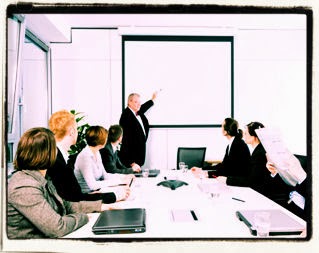How to Make Your Meeting Rooms Speaker Friendly
When you are speaking or presenting away from your own
office you will often have to deal with awkward room arrangements, like projectors
that shine in your eyes, dry markers and other problems. This is just something you have to
learn to live with and a good speaker should be able to work effectively in any situation. But when it is your own meeting room that is causing you problems
then instead of learning to live with it you should be trying to fix it.
If you are the boss you can simply tell someone to fix it;
if you are lower in the hierarchy you can still influence the decision makers
to improve the room since it is in their interests, too. In both cases you will need to know how to
make a meeting room speaker friendly. Here are some practical tips:
MAKE SURE THAT THERE IS SPACE FOR THE SPEAKER. Between the furniture and the wall there
should be enough room for the speaker to move in a natural way. I have seen
meeting rooms where the space between table and wall is so small you cannot
move at all; this makes speakers feel uncomfortable and gives them no space to avoid light from the projector.
ARRANGE PROJECTOR BEHIND OR BESIDE SPEAKER. When the light from the projector shines in
the speaker’s eyes this is distracting for everybody. In typical office
buildings with low ceilings this is actually quite hard to avoid, though you
can do it either by having the projector and screen to one side or by placing
the projector high above the screen and using the keystone correction to
restore a normal rectangular image. In this was you can arrange the beam so
that it avoids the speaker’s face.
INSTALL SEPARATE LIGHT SWITCHES FOR FRONT AND REST OF ROOM. To make
it easier to read images on the screen it helps if the lights closest to it can
be turned off separately from the rest. You should also have manual light
switches and not movement sensors. Motion activated lights are good for saving
energy but they can be very distracting when the lights come on when you want
them off and vice-versa.
DON’T FIX THE FURNITURE TO THE FLOOR. For a traditional
eye-contact meeting you might want a boardroom style table; for a workshop or
interactive seminar a U shaped table is more effective and there can be other
configurations that work for different uses. Fixing the tables to the floor
means that nobody can rearrange the room optimally. Often tables are fixed
because they are equipped with power and network sockets so use instead mobile
power strips and WiFi networks, providing fixed sockets only on the walls and in covered holes in the floor.
MAKE SURE THERE ARE PLENTY OF SUPPLIES. An unproductive meeting costs your business much more than a packet of whiteboard markers. Making sure that there is a stock of usable markers, paper and other supplies in the room not only saves time it also boosts your reputation with visitors. People notice these things and they remember. These days you should also make sure you have the right adapters for common laptop types.
You might think that you can rely on your architect to take care of this but this doesn't work if they have no experience in speaking and it doesn't work if you specify conflicting requirements. If you ask for a speaker-friendly meeting room but then require that every table position have a power socket you are asking the impossible. You will get better results by asking a professional speaker or at least someone with plenty of speaking experience to review the plans.
+
Lectures, Workshops, Coaching & Writing
For lectures, workshops, coaching and writing on this and other communication topics visit http://andrewhennigan.com, email speaker@andrewhennigan.com or call 0046 730 894 475 (Sweden).



Comments
Best
Andrew